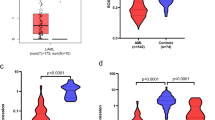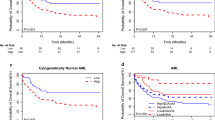Abstract
The increased metabolism in acute myeloid leukemia (AML) malignant cells resulted in the production of high levels of free radicals, called oxidative stress conditions. To avoid this situation, malignant cells produce a considerable amount of antioxidant agents, which will lead to the release of a continuous low level of reactive oxygen species (ROS), causing genomic damage and subsequent clonal evolution. SIRT1 has a key role in driving the adaptation to this condition, mainly through the deacetylation of FOXO3a that affects the expression of oxidative stress resistance target genes such as Catalase and Manganese superoxide dismutase (MnSOD). The aim of this study is to simultaneously investigate the expression of SIRT1, FOXO3a, and free radical-neutralizing enzymes such as Catalase and MnSOD in AML patients and measure their simultaneous change in relation to each other. The gene expression was analyzed using Real Time-PCR in 65 AML patients and 10 healthy controls. Our finding revealed that expression of SIRT1, FOXO3a, MnSOD and Catalase was significantly higher in AML patients in comparison to healthy controls. Also, there was a significant correlation between the expression of SIRT1 and FOXO3a, as well as among the expression of FOXO3a, MnSOD and Catalase genes in patients. According to the results, the expression of genes involved in oxidative stress resistance was higher in AML patients, which possibly contributed to the development of malignant clones. Also, the correlation between the expression of SIRT1 and FOXO3a gene reflects the importance of these two genes in increased oxidative stress resistance of cancer cells.





Similar content being viewed by others
References
Löwenberg B, Rowe JM (2016) Introduction to the review series on advances in acute myeloid leukemia (AML). American Society of Hematology Washington, DC. pp 1–1
Grimwade D, Ivey A, Huntly BJ (2016) Molecular landscape of acute myeloid leukemia in younger adults and its clinical relevance blood. J Am Soc Hematol 127(1):29–41
Khwaja A et al (2016) Acute myeloid leukaemia. Nat Rev Dis Primers 2(1):1–22
Shipley JL, Butera JN (2009) Acute myelogenous leukemia. Exp Hematol 37(6):649–658
Döhner H et al (2010) Diagnosis and management of acute myeloid leukemia in adults: recommendations from an international expert panel, on behalf of the european LeukemiaNet. Blood J Am Soc Hematol 115(3):453–474
Scandalios JG (2005) Oxidative stress: molecular perception and transduction of signals triggering antioxidant gene defenses. Braz J Med Biol Res 38:995–1014
Sies H (1997) Oxidative stress: oxidants and antioxidants. Exp Physiol Trans Integr 82(2):291–295
Hart PC et al (2015) MnSOD upregulation sustains the Warburg effect via mitochondrial ROS and AMPK-dependent signalling in cancer. Nat Commun 6(1):1–14
Allahbakhshian-Farsani M et al (2014) Cytogentic analysis of human dermal fibroblasts (HDFs) in early and late passages using both karyotyping and comet assay techniques. Cytotechnology 66(5):815–822
Oellerich MF, Potente M (2012) FOXOs and sirtuins in vascular growth, maintenance, and aging. Circul Res 110(9):1238–1251
Farsani MA et al (2020) The expression of interferon gamma (IFN-γ) and interleukin 6 (IL6) in patients with acute lymphoblastic leukemia (ALL). Pathol Oncol Res 26(1):461–466
Mohamadimaram M, Farsani MA, Mirzaeian A (2019) Evaluation of ATG7 and light chain 3 (LC3) autophagy genes expression in AML patients. Iran J Pharm Res IJPR 18(2):1060
Jabari M et al (2019) Hypoxia-inducible factor 1-Α (HIF1α) and vascular endothelial growth Factor-A (VEGF-A) expression in De Novo AML Patients. Asian Pac J Cancer Prev APJCP 20(3):705
Salarpour F et al (2017) Evaluation of CCAAT/Enhancer binding protein (C/EBP) alpha (CEBPA) and runt-related transcription factor 1 (RUNX1) expression in patients with De Novo Acute myeloid leukemia. Ann Hum Genet 81(6):276–283
Wampfler J et al (2009) SIRT1 is downregulated during neutrophil differentiation of acute promyelocytic leukaemia cells. Br J Haematol 146(3):337–341
Bradbury C et al (2005) Histone deacetylases in acute myeloid leukaemia show a distinctive pattern of expression that changes selectively in response to deacetylase inhibitors. Leukemia 19(10):1751–1759
Yi J, Luo J (2010) SIRT1 and p53, effect on cancer, senescence and beyond. Biochim et Biophys Acta (BBA)-Proteins Proteom 1804(8):1684–1689
Li L et al (2014) SIRT1 activation by a c-MYC oncogenic network promotes the maintenance and drug resistance of human FLT3-ITD acute myeloid leukemia stem cells. Cell Stem Cell 15(4):431–446
Stankov MV et al (2014) Histone deacetylase inhibitors induce apoptosis in myeloid leukemia by suppressing autophagy. Leukemia 28(3):577–588
Villaa R et al (2004) Epigenetic gene silencing in acute promyelocytic leukemia. Biochem Pharmacol 68(6):1247–1254
van der Horst A, Burgering BM (2007) Stressing the role of FoxO proteins in lifespan and disease. Nat Rev Mol Cell Biol 8(6):440–450
Hori YS et al (2013) Regulation of FOXOs and p53 by SIRT1 modulators under oxidative stress. PLoS ONE 8(9):e73875
Wang Z et al (2013) SIRT1 deacetylase promotes acquisition of genetic mutations for drug resistance in CML cells. Oncogene 32(5):589–598
Yun JM et al (2012) Resveratrol up-regulates SIRT1 and inhibits cellular oxidative stress in the diabetic milieu: mechanistic insights. J Nutr Biochem 23(7):699–705
Giannakou ME, Partridge L (2004) The interaction between FOXO and SIRT1: tipping the balance towards survival. Trends Cell Biol 14(8):408–412
Ding S et al (2015) Redox regulation in cancer stem cells. Oxid Med Cell Longev, 2015
Hole PS, Darley RL, Tonks A (2011) Do reactive oxygen species play a role in myeloid leukemias? Blood J Am Soc Hematol 117(22):5816–5826
Li P et al (2016) Redox homeostasis protects mitochondria through accelerating ROS conversion to enhance hypoxia resistance in cancer cells. Sci Rep 6(1):1–13
Udensi UK, Tchounwou PB (2014) Dual effect of oxidative stress on leukemia cancer induction and treatment. J Exp Clin Cancer Res 33(1):1–15
Rajeshwari U et al (2013) Oxidative stress and antioxidant status in acute and chronic myeloid leukemia patients. Open J Blood Dis, 2013
Gorrini C, Harris IS, Mak TW (2013) Modulation of oxidative stress as an anticancer strategy. Nat Rev Drug Discovery 12(12):931–947
Wouters BJ, Delwel R (2016) Epigenetics and approaches to targeted epigenetic therapy in acute myeloid leukemia. Blood J Am Soc Hematol 127(1):42–52
Roth M, Chen W (2014) Sorting out functions of sirtuins in cancer. Oncogene 33(13):1609–1620
Farquhar MJ, Bowen DT (2003) Oxidative stress and the myelodysplastic syndromes. Int J Hematol 77(4):342–350
Brunet A et al (2004) Stress-dependent regulation of FOXO transcription factors by the SIRT1 deacetylase. Science 303(5666):2011–2015
Li L, Bhatia R (2015) Role of SIRT1 in the growth and regulation of normal hematopoietic and leukemia stem cells. Curr Opin Hematol 22(4):324
Chen X et al (2014) High levels of SIRT1 expression enhance tumorigenesis and associate with a poor prognosis of colorectal carcinoma patients. Sci Rep 4(1):1–12
Goudarzipour K, Ahmadzadeh A, Mohammadi MH (2017) Changes of AML 1 and P53 tumor suppressor gene expression in patients de novo acute myeloid leukemia. Arch Adv Biosci 8(1):39–45
Accili D, Arden KC (2004) FoxOs at the crossroads of cellular metabolism, differentiation, and transformation. Cell 117(4):421–426
Tothova Z et al (2007) FoxOs are critical mediators of hematopoietic stem cell resistance to physiologic oxidative stress. Cell 128(2):325–339
Miriyala S et al (2012) Manganese superoxide dismutase, MnSOD and its mimics. Biochimica et Biophysica Acta (BBA)-Molecular Basis of Disease 1822:794–815
Huang P et al (2000) Superoxide dismutase as a target for the selective killing of cancer cells. Nature 407(6802):390–395
Miar A et al (2015) Manganese superoxide dismutase (SOD2/MnSOD)/catalase and SOD2/GPx1 ratios as biomarkers for tumor progression and metastasis in prostate, colon, and lung cancer. Free Radic Biol Med 85:45–55
Kamarajugadda S et al (2013) Manganese superoxide dismutase promotes anoikis resistance and tumor metastasis. Cell Death Dis 4(2):e504–e504
Yeung B et al (2008) Chemosensitisation by manganese superoxide dismutase inhibition is caspase-9 dependent and involves extracellular signal-regulated kinase 1/2. Br J Cancer 99(2):283–293
Röhrdanz E et al (2001) The influence of oxidative stress on catalase and MnSOD gene transcription in astrocytes. Brain Res 900(1):128–136
Acknowledgements
This work was supported by the Shahid Beheshti University of Medical Sciences (SBMU) grant funded by the Iranian Government (10319).
Author information
Authors and Affiliations
Corresponding author
Ethics declarations
Conflict of interest
The authors declare that they have no conflict of interest.
Additional information
Publisher’s Note
Springer Nature remains neutral with regard to jurisdictional claims in published maps and institutional affiliations.
Rights and permissions
Springer Nature or its licensor (e.g. a society or other partner) holds exclusive rights to this article under a publishing agreement with the author(s) or other rightsholder(s); author self-archiving of the accepted manuscript version of this article is solely governed by the terms of such publishing agreement and applicable law.
About this article
Cite this article
Mizani, S., Keshavarz, A., Vazifeh Shiran, N. et al. Expression Changes of SIRT1 and FOXO3a Significantly Correlate with Oxidative Stress Resistance Genes in AML Patients. Indian J Hematol Blood Transfus 39, 392–401 (2023). https://doi.org/10.1007/s12288-022-01612-3
Received:
Accepted:
Published:
Issue Date:
DOI: https://doi.org/10.1007/s12288-022-01612-3




